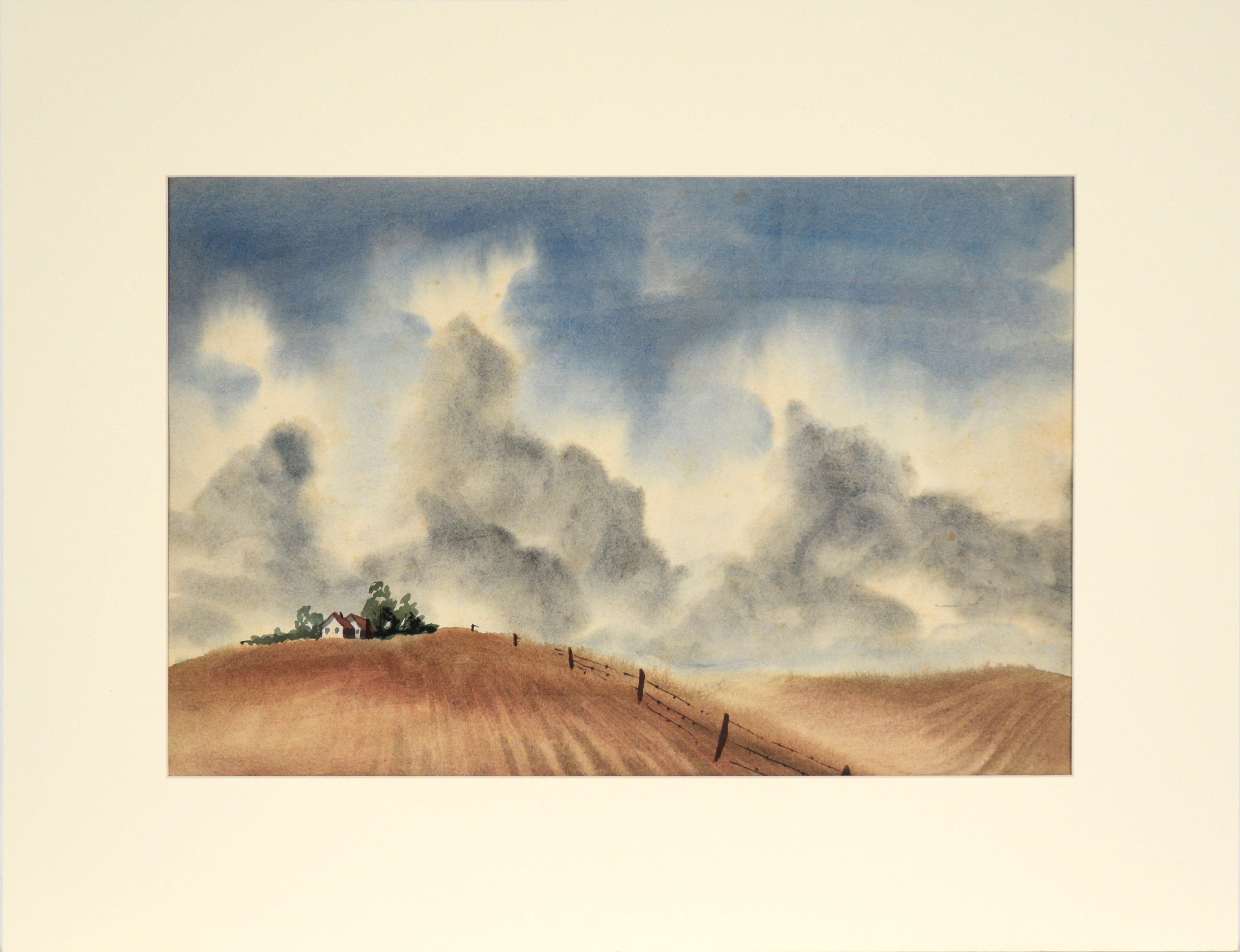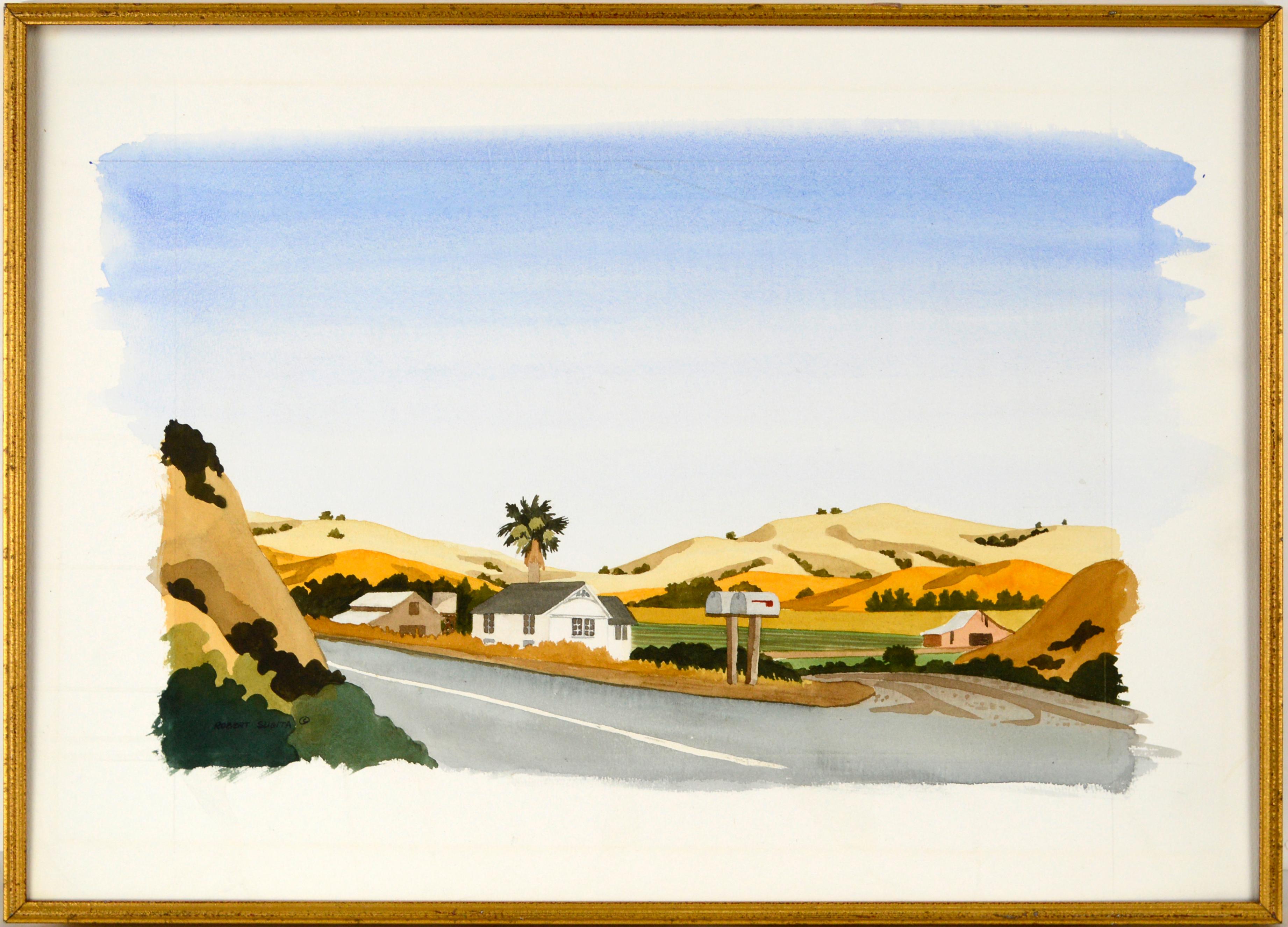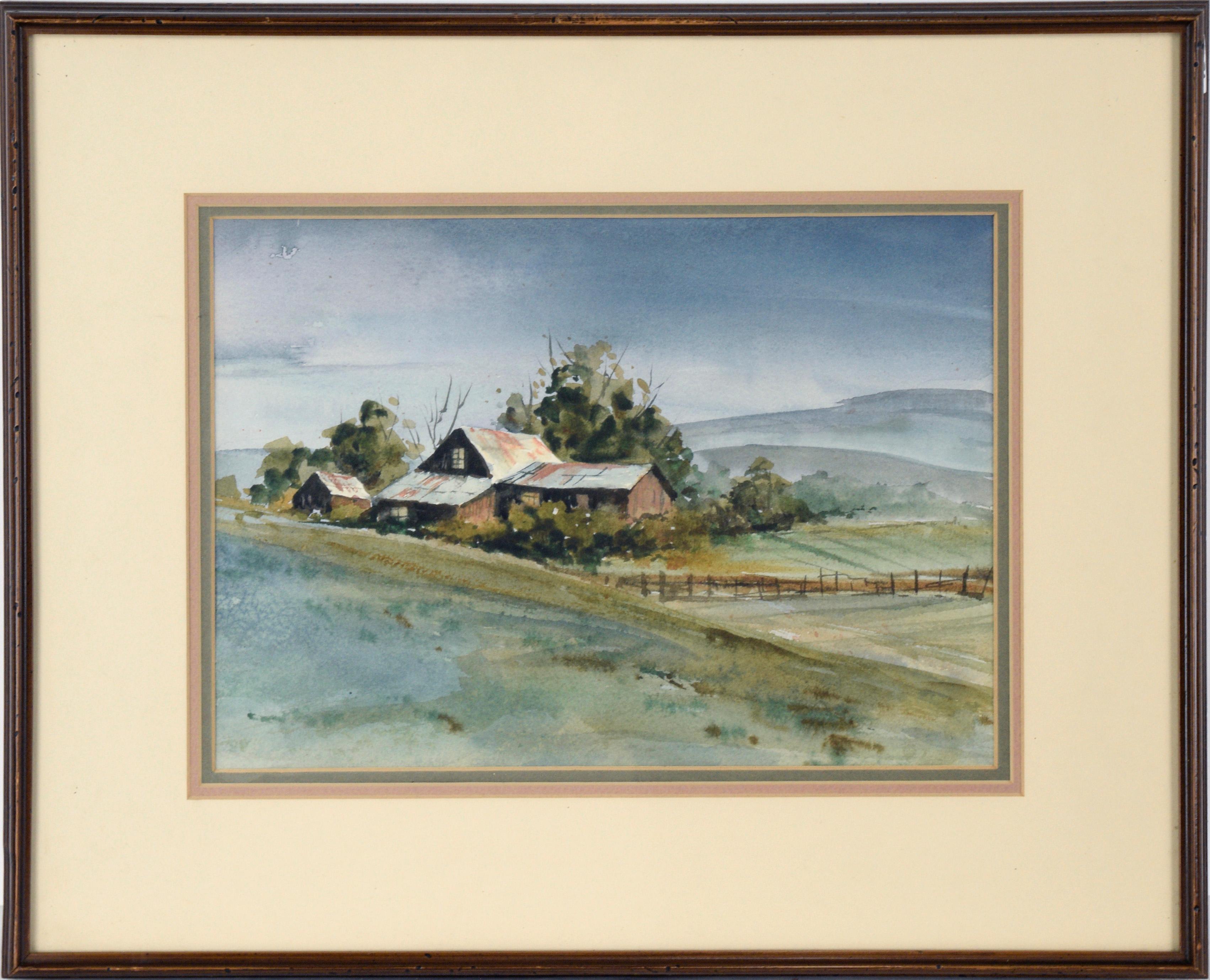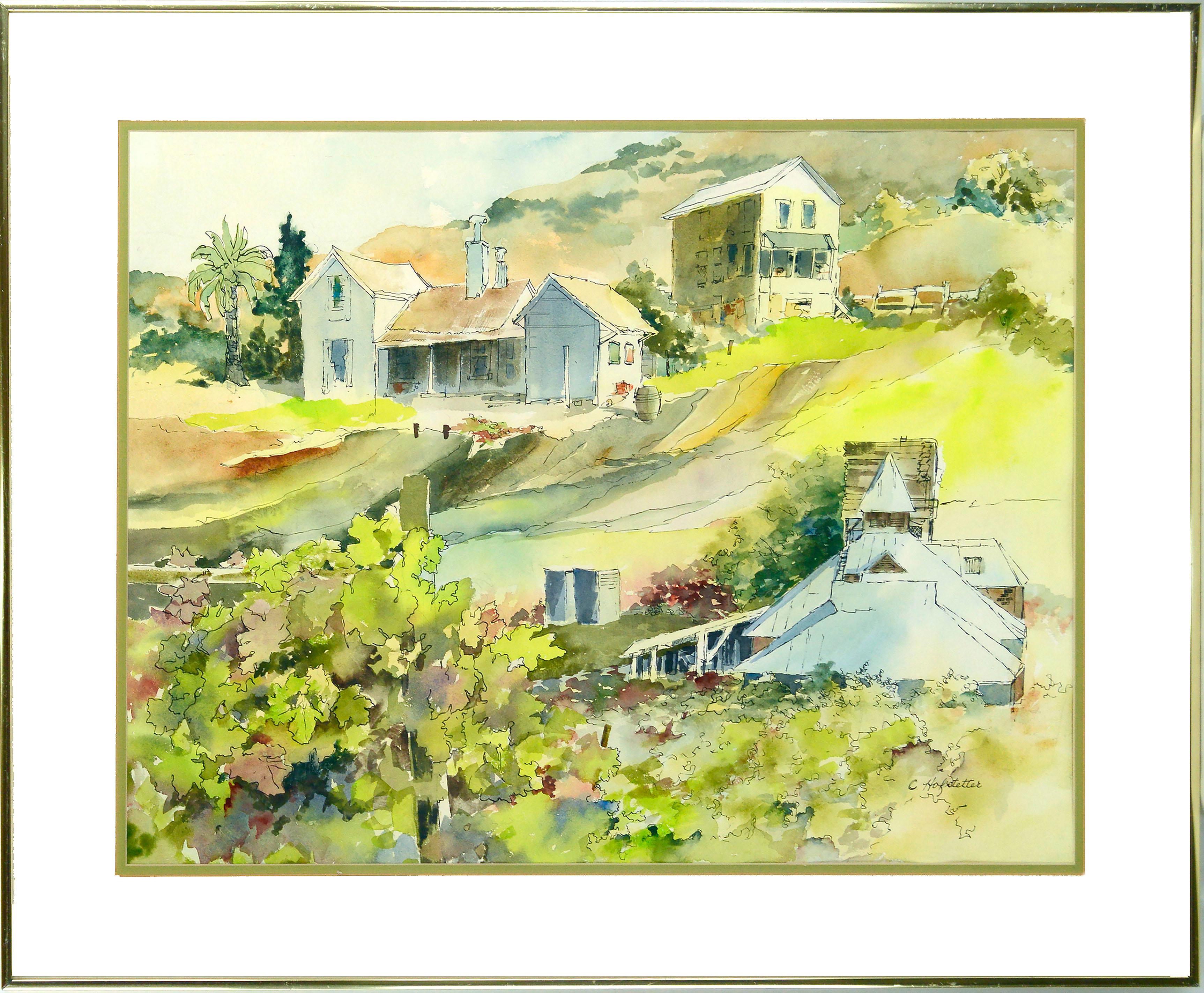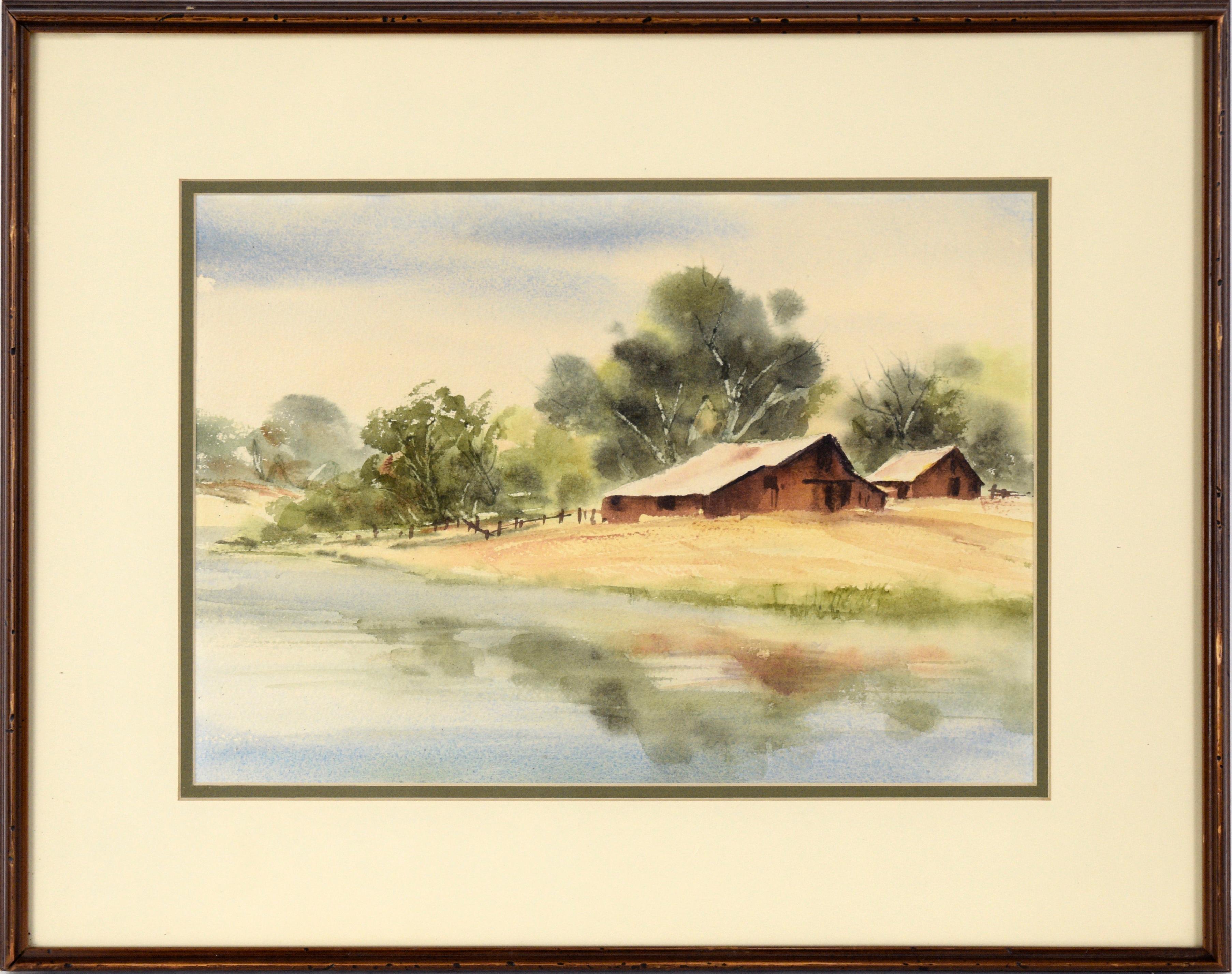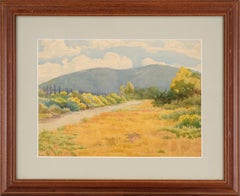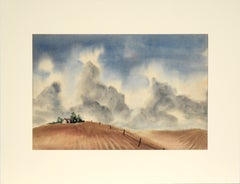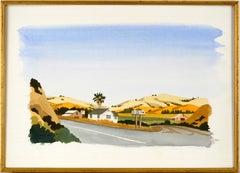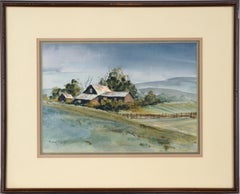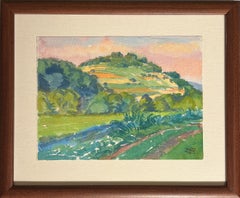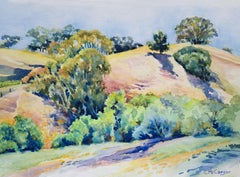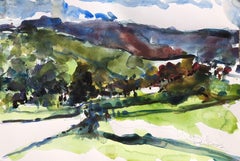Items Similar to Golden Hills - California Landscape in Watercolor on Paper
Want more images or videos?
Request additional images or videos from the seller
1 of 13
Robert Gantt SteeleGolden Hills - California Landscape in Watercolor on Paper21st Century
21st Century
$975
£736.23
€848.42
CA$1,376.14
A$1,517.16
CHF 793.73
MX$18,612.76
NOK 9,991.49
SEK 9,343.63
DKK 6,336.06
About the Item
Golden Hills - California Landscape in Watercolor on Paper
Lively watercolor by notable California artist Robert Gantt Steele (American, b. 1946). A simple wood fence runs along a golden hill, drawing the viewer's eye to the mid ground. There, a line of trees casts shadows on the hillside. A rich blue sky completes the scene.
Signed "R Steele" in the lower right corner
Presented "floating" in a simple wood frame
Frame size: 16"H x 20"W
Paper size: 11.75"H x 15.5"W
Robert G. Steele (American, b. 1946) was originally trained as an architect and studied art in Austria as a Fulbright scholar. He has painted for Broadway productions, Smithsonian Magazine, the National Park Service magazines, and many adult and children's books. He lives in California with his wife and children.
Education:
Bachelor of Architecture, North Carolina State University
Master of Architecture, University of California, Berkeley
Fulbright Grant, Vienna, Austria, Painting Study
Art Students League, Painting Study
Memberships:
Academy of Art College, San Francisco, Former Instructor
American Society of Marine Artists, Signature Member
California Art Club, Artist Member
Oil Painter of America and American Impressionist Society
United States Air Force Art Program
- Creator:Robert Gantt Steele (1946, American)
- Creation Year:21st Century
- Dimensions:Height: 16 in (40.64 cm)Width: 20 in (50.8 cm)Depth: 0.75 in (1.91 cm)
- Medium:
- Movement & Style:
- Period:
- Condition:Very good condition. Frame has light wear.
- Gallery Location:Soquel, CA
- Reference Number:Seller: 0232_DBH1stDibs: LU54211541032
About the Seller
5.0
Platinum Seller
Premium sellers with a 4.7+ rating and 24-hour response times
Established in 1986
1stDibs seller since 2014
2,990 sales on 1stDibs
Typical response time: <1 hour
- ShippingRetrieving quote...Shipping from: Soquel, CA
- Return Policy
Authenticity Guarantee
In the unlikely event there’s an issue with an item’s authenticity, contact us within 1 year for a full refund. DetailsMoney-Back Guarantee
If your item is not as described, is damaged in transit, or does not arrive, contact us within 7 days for a full refund. Details24-Hour Cancellation
You have a 24-hour grace period in which to reconsider your purchase, with no questions asked.Vetted Professional Sellers
Our world-class sellers must adhere to strict standards for service and quality, maintaining the integrity of our listings.Price-Match Guarantee
If you find that a seller listed the same item for a lower price elsewhere, we’ll match it.Trusted Global Delivery
Our best-in-class carrier network provides specialized shipping options worldwide, including custom delivery.More From This Seller
View AllCalifornia Hills, Mid Century Landscape Watercolor
Located in Soquel, CA
Vibrant watercolor by an unknown artist, in the style of Elmer Wachtel (American, 1864 - 1929). This mid-century landscape watercolor features a golden yellow meadow beside a country...
Category
Mid-20th Century American Impressionist Landscape Drawings and Watercolors
Materials
Watercolor, Laid Paper
California Farmhouse Landscape in Watercolor on Paper (Two Sided)
Located in Soquel, CA
California Farmhouse Landscape in Watercolor on Paper
Original watercolor painting of a farmhouse at the top of a hill by Bertram Spencer (American, 1918-1992). A small farmhouse si...
Category
1950s American Impressionist Landscape Paintings
Materials
Paper, Watercolor
San Jose Hills Watercolor on paper
Located in Soquel, CA
San Jose Hills Watercolor on paper
An Americana view of the Hills around San Jose by Robert Sugita (American, b- 1938). A Cupertino artist, Robert went ...
Category
1980s American Impressionist Landscape Drawings and Watercolors
Materials
Paper, Watercolor
Farmhouse Amador Foothills - Rural California Landscape in Watercolor on Paper
Located in Soquel, CA
Farmhouse in the Foothills - Rural California Landscape in Watercolor on Paper
Idyllic country landscape by California artist Alice Duke (American, 1921-2012). Amador County California. A rustic farmhouse sits at the bottom of a sloping hill at dusk. The sky is a misty grey blue, as if the sun has just recently set. Just below the farmhouse, there are a few fields divided by a simple fence.
Titled a signed on verso “Amador County Alice Duke” “AC23”. Presented in a vintage frame with a double mat.
Frame size: 16.75"H x 20.75"W
Image size: 10"H x 14"W
Duke, Alice (American, 1921-2012) was an artist from Jackson, California. She was a student of Dorner Schueler.
Memberships:
Founding member, Gallery 10.
Member, Northern California Arts.
Member, Society of Western Artist
Shows and Awards:
1999 - Gallery 10, Sutter Creek, CA
1986 - (1st Place, Watercolors) Sonoma Valley Art Center, Sonoma, CA
1985 - (Hon. Mention, Watercolors) Sonoma Valley Art Center, Sonoma, CA
1982 - Sunshine Art...
Category
Mid-20th Century American Impressionist Landscape Drawings and Watercolors
Materials
Paper, Watercolor
California Vineyard, Large-Scale Farmhouse Landscape Watercolor
By Carolyn Hofstetter
Located in Soquel, CA
Vibrant large-scale landscape watercolor of a California vineyard by S.W.A. artist Carolyn Hofstetter (American, b.1927). This beautiful scene of ...
Category
Late 20th Century American Impressionist Landscape Drawings and Watercolors
Materials
Paper, Watercolor
"Shenandoah Valley" - Rural California Landscape in Watercolor on Paper
Located in Soquel, CA
"Shenandoah Valley" - Rural California Landscape in Watercolor on Paper
Idyllic country landscape by California artist Alice M. Duke (American, 1921-2012). Two large brown-red barns sit at the edge of a glassy body of water. They are surrounded by towering dark green trees, which are reflected in the water along with the barns. Titled "Shenandoah Valley"; California Shenandoah Valley AVA is an American Viticultural Area that includes portions of Amador County and El Dorado County, California, United States. It is a sub-region of the Sierra Foothills.
titled "shenandoah Valley" and monogrammed AC #25 on mat verso verso.
(we have two others with signed labels "Alice Duke" and initialed AC #23 & AC #24 by this artist)
Presented in a vintage frame with a double mat.
Frame size: 16.75"H x 20.75"W
Image size: 10"H x 14"W
Duke, Alice (American, 1921-2012 was an artist from Jackson, California. She was a student of Dorner Schueler. A member and exhibitor with the Central Coast Art League.
Memberships:
Founding member, Gallery 10.
Central California Art League
Member, Northern California Arts.
Member, Society of Western Artist
Shows and Awards:
1999 - Gallery 10, Sutter Creek, CA
1986 - (1st Place, Watercolors) Sonoma Valley Art Center, Sonoma, CA
1985 - (Hon. Mention, Watercolors) Sonoma Valley Art Center, Sonoma, CA
1982 - Sunshine Art...
Category
1960s American Impressionist Landscape Drawings and Watercolors
Materials
Paper, Watercolor
You May Also Like
California Landscape with Farm
Located in San Francisco, CA
This artwork "California Landscape with Farm" 1943 is a watercolor on paper by noted California (German/American) artist Ernst Stolz, 1901-1989. It is signed and dated at the lower r...
Category
Mid-20th Century American Impressionist Landscape Drawings and Watercolors
Materials
Watercolor
Mid Century "Napa Valley Landscape" Watercolor Painting
By Frederick Pomeroy
Located in Arp, TX
Frederick Pomeroy
"Napa Valley Landscape"
c. 1960s
Watercolor on paper
17"x14" brown wood frame float mount over linen mat
Signed in paint lower ...
Category
1960s American Modern Landscape Drawings and Watercolors
Materials
Watercolor, Archival Paper
California Summer Hills, Original Painting
By Catherine McCargar
Located in San Francisco, CA
Artist Comments
Tree-studded hills and valleys in California glow under the summer sun. Dramatic shadows in deep blues and purples dot the golden grass, creating a striking c...
Category
21st Century and Contemporary Impressionist More Art
Materials
Watercolor
Santa Ynez Valley, Painting, Watercolor on Watercolor Paper
By Daniel Clarke
Located in Yardley, PA
The Santa Ynez Valley is located in Santa Barbara County, California, between the Santa Ynez Mountains to the south and the San Rafael Mountains to the north. The Santa Ynez River flows through the valley from east to west. The Santa Ynez Valley is separated from the Los Alamos Valley, to the northwest, by the Purisima Hills, and from the Santa Maria Valley by the Solomon Hills.[1][2] The Santa Rita Hills separate the Santa Ynez Valley from the Santa Rita and Lompoc Valleys to the west.[3][4][5] The valley has a population of about 20,000 residents living in the communities of Solvang, Los Olivos...
Category
2010s Impressionist Drawings and Watercolor Paintings
Materials
Watercolor
Western Landscape, Modern Watercolor by Allen Tucker 1931
By Allen Tucker
Located in Long Island City, NY
Artist: Allen Tucker, American (1866 - 1939)
Title: Western Landscape
Year: 1931
Medium: Watercolor on paper, signed and dated
Size: 14 in. x 20 in. (35.56 cm x 50.8 cm)
Category
1930s American Impressionist Landscape Drawings and Watercolors
Materials
Watercolor
Sonoma County Landscape
Located in San Francisco, CA
This artwork "Sonoma County Landscape" 1901, is a watercolor on paper by noted California artist Elizabeth Hoen, 1868-1955. It is signed and dated at the lower right corner by the artist. The artwork (image) size is 6 x 7.5 inches, framed size is 12.5 x 13.65 inches. Custom framed in a gold frame, with beige matting. It is in excellent condition.
About the artist:
Born in Santa Rosa, California to a pioneering California family, Elizabeth Hoen was known for her watercolor paintings, many of them landscapes, in impressionist style. Her father, Berthold Hoen started a trading post in the Carillo adobe, the first building erected in the Sonoma Valley. He also helped survey and lay out the city of Santa Rosa.
Elizabeth Hoen is not only the first painter to have their work cataloged into the Sonoma County Museum’s collection, but she was also a prolific artist in California in the late 19th and early 20th centuries and maintained a studio during a period when California art was largely dominated by men. She was from an important family in early Sonoma County history. Her father, Berthold Hoen, purchased land from the Carrillo family that would one day be...
Category
Early 20th Century American Impressionist Landscape Drawings and Waterco...
Materials
Watercolor
More Ways To Browse
Austria Painting
North Carolina Landscape Painting Oil
American Signature
California Artist Oil
G W Hill
Berkeley Painting
Robert Hills
Adult Magazine
John Ireland
Kent Oil Paintings
French Barn
Moody Landscape Oil
18 X 20 Oil Painting
Affordable Paintings
Oil Paintings 1939 German
Sell Art
Monet Original Art
Oil Painting Snow In Cities

